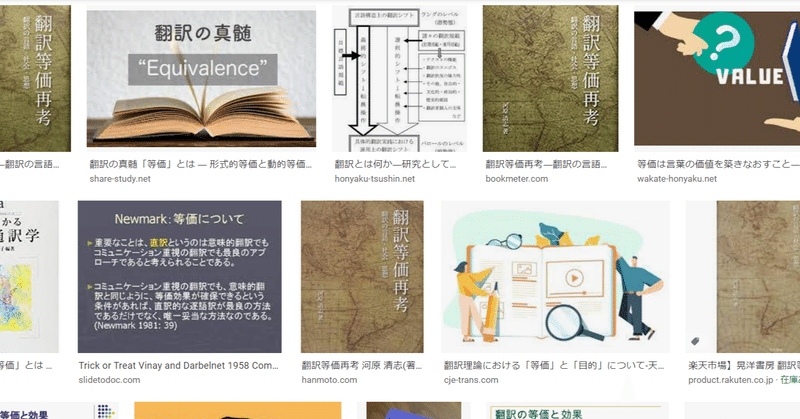
「翻訳と等価」について私の意見を以下に述べる。
設問 日本語での論述試験です。
翻訳学における「等価(Equivalence)」という概念についてその一般的な意味を説明しながら、「翻訳と等価」について、あなたの意見を述べてください。必要であれば具体的な翻訳の例を入れてもかまいません。日本語で800〜1000字(少々多くなってもOK)。
「翻訳と等価」について私の意見を以下に述べる。
等価と聞くと、等価交換を思い出す。それは、パチンコ屋・パチスロ店で購入した玉・コインを同じ値段で交換できる俗語というイメージが強い。単純に、等しい価値を持つことをいうものと解釈されている。若干交換レートがお店側に利益が出るような交換レートになっていることもあり、完全等価のお店 は、沖縄には少ないのかもしれない。これらが、一般、世間的な等価の概念であろう。翻訳額における「等価」については、以下に述べることにする。
なぜ、英語(起点言語:souce text)を適切な日本語(目標言語:target text)に訳せないのか。または苦労するのか。英語と日本語はそもそも言葉であり、それぞれを正確に説明しあえない現象が生じるのはなぜなのだろうか。それが、この論述のテーマである等価(equivalence)というものにつながるのではないか。
弊社の英語話者の外国籍の設計者が1名で、弊社社員6名、先方社4名の合計11名である日、設計変更の打ち合わせしていたのですが、その設計者との英語でコミュニケーションが可能なのは、弊社社員のみですが、正確に打ち合わせ内容を齟齬なく等価に意図伝達できたのかどうかといつも疑問が残っている。日本人同士であっても、同じ日本語でも情報伝達における理解度は、個人差があるものである。さらに、各自の意図するところの概念を英語で伝えあうことが円滑にいっているのか、非常に疑問であり、それらも相まってプロジェクトの遅延が起きている状況にある。プロジェクトの遅延や翻訳等価に至らないことの解消のためにも、いわゆる翻訳的な要素や技術を身に付け、英語話者への情報伝達をするコミュニケーション時等に、同技術が活用できるようになれればとおもい講義を拝聴しているところである。日本国籍以外の英語話者にとって等価の概念がこちらと同じであるかどうか疑問はあるものの、Is that equivalent to our discussion ? みたいな表現を使って、試験的に意図伝達の精度を向上していこうかとおもっている。
翻訳の仕方と通訳の仕方はどのような差があるのだろうか。講義では、翻訳という場合、通訳も含む場合も多いとされ、明確な線引きが難しい場合もあると解説されていた。また、直訳・意訳・超訳などした場合に、等価と言えるのだろうか。
私の翻訳ストラテジーは、昨今ではもっぱらDeepLに偏っており、かなり重宝している。翻訳学者のチェスターマンを研究した方々もいらっしゃるようで、興味深い。結局、等価に伝えるためには、等価を補足しうる情報が必要でもあり、情報が足りなかったり、削ったり、省略することは、等価に当たらないのではないかと思われる。確かに、打ち合わせに長けている方は、言い換えや、受け身に表現方法を変化させ、受け手が理解しやすいように表現を工夫していることが多い。
どちらかといえば、完全等価については、個人的には否定的な印象を持っており、STとTTを等価にするのは不可能であるに近い印象である。その方が精神的に楽であるし、時間の節約になると考えている。
以上(1,354文字)
中間テストとは関係ないが、以下に、Deepl翻訳が果たして等価かどうかを参考に示すことにする。(上記の論述をDeeplで翻訳し、その翻訳された英語をDeeplで日本語にしました)
The following is my opinion on "translation and equivalence.
When I hear the word "equivalent," I think of equivalent exchange. It has a strong image as a slang term for the exchange of balls and coins purchased at pachinko parlors and pachislot parlors at the same price. It is simply interpreted to mean that they have equal value. In Okinawa, there may be few stores that offer the exact equivalent exchange rate, because the exchange rate is set so that the stores can make a profit. These are the general concepts of equivalence in the world. I will discuss "equivalent" in terms of translated amounts below.
Why can't we translate English (source text) into appropriate Japanese (target text)? Or, why do we have trouble? English and Japanese are languages in the first place, so why is it that they cannot be accurately explained to each other? This may lead to the theme of this essay, equivalence.
One day, one of our company's English-speaking foreign designers, six of our company's employees, and four of the client company's employees, for a total of 11 people, had a meeting to discuss design changes. I am always left with a question. Even among Japanese people, there are individual differences in the level of understanding of information conveyed even in the same Japanese language. In addition, it is very doubtful whether it is smooth to communicate the concept of each person's intentions in English, and this, combined with other factors, has caused delays in the project. In order to solve the problem of project delays and the lack of translation equivalence, I am listening to the lecture with the hope that I can acquire so-called translation elements and techniques, and be able to use them when communicating information to English speakers. Although I have some doubts about whether the concept of equivalence is the same for non-Japanese speakers of English as it is for Japanese speakers, I have been using expressions such as "Is that equivalent to our discussion? I'm thinking of using expressions like "Is that equivalent to our discussion?
What is the difference between translation and interpretation? In the lecture, it was explained that translation often includes interpretation, and that it is sometimes difficult to draw a clear line. I also wondered if direct translation, intentional translation, and super-translation could be considered equivalent.
My translation strategy nowadays is exclusively based on DeepL, which I find quite useful. It is interesting to note that there are some translation scholars who have studied Chesterman. In the end, it seems to me that in order to communicate equivalently, we need information that can supplement the equivalence, and that not having enough information, cutting it out, or omitting it does not constitute equivalence. It is true that those who are skilled in meetings often paraphrase or change the way they express themselves passively to make it easier for the receiver to understand.
If anything, I personally have a negative impression about perfect equivalence, and my impression is that it is close to impossible to make ST and TT equivalent. I think it would be mentally easier and save a lot of time.
Above (525 words)
以下は、「翻訳と等価性」についての私の意見です。
私は「等価」という言葉を聞くと、等価交換を思い浮かべます。パチンコ店とパチスロ店で購入した玉やコインを同じ値段で交換するスラングとしてのイメージが強いですね。単純に「価値が同じ」という意味で解釈されています。沖縄では、店側が利益を出せるように交換レートが設定されているため、正確な等価交換を行っている店は少ないかもしれません。以上が、世の中の一般的な「等価」の概念です。以下、翻訳された金額の観点から「等価」について説明します。
なぜ、英語(ソーステキスト)を適切な日本語(ターゲットテキスト)に翻訳できないのか?というか、なぜ困るのか。そもそも英語も日本語も言語なのに、なぜ正確に説明できないのか。それは、このエッセイのテーマである「等価性」につながるのではないでしょうか。
ある日、当社の英語圏の外国人デザイナー1名と、当社の社員6名、クライアント企業の社員4名の計11名で、デザイン変更の打ち合わせを行いました。私にはいつも疑問が残ります。日本人同士でも、同じ日本語でも伝えられた情報の理解度には個人差があります。また、各人の意図する概念を英語でスムーズに伝えることができるかどうかは非常に疑問であり、そのことも相まってプロジェクトの遅延につながっています。プロジェクトの遅延や翻訳の等価性の問題を解決するために、いわゆる翻訳の要素やテクニックを身につけて、英語圏の人に情報を伝えるときに使えるようになればいいなと思って講義を聞いています。日本語を母国語としない英語話者にとって、等価性の概念が日本語話者と同じであるかどうかについては疑問がありますが、「Is that equivalent to our discussion? Is that equivalent to our discussion? "といった表現を使おうと思っています。
翻訳と通訳の違いは何ですか?講義では、翻訳には解釈が含まれることが多く、明確な線引きが難しいことがあると説明されていました。また、直訳、意訳、超訳なども等価と言えるのか疑問に思いました。
最近の私の翻訳戦略は、もっぱらDeepL、かなり重宝しています。チェスターマンを研究している翻訳学者がいることも興味深いですね。結局、同等のコミュニケーションをするためには、同等性を補う情報が必要であり、情報が足りなかったり、切り取ったり、省略したりすることは、同等性にはならないということになるようです。たしかに、会議に長けている人は、受け手が理解しやすいように言い換えたり、受動的な表現方法を変えたりすることが多いですね。
どちらかというと、個人的には完全な等価性には否定的な印象を持っていて、STとTTを等価にするのは不可能に近いという印象を持っています。その方が精神的に楽だし、時間の節約にもなると思うのですが。
以上(1,186文字)
この記事が気に入ったらサポートをしてみませんか?
